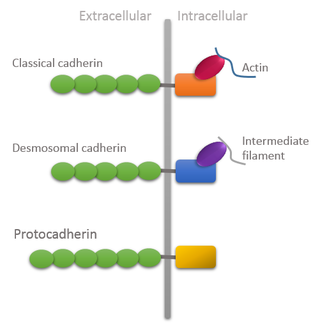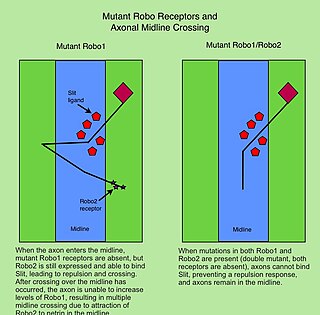Related Research Articles
Synaptogenesis is the formation of synapses between neurons in the nervous system. Although it occurs throughout a healthy person's lifespan, an explosion of synapse formation occurs during early brain development, known as exuberant synaptogenesis. Synaptogenesis is particularly important during an individual's critical period, during which there is a certain degree of synaptic pruning due to competition for neural growth factors by neurons and synapses. Processes that are not used, or inhibited during their critical period will fail to develop normally later on in life.

DSCAM and Dscam are both abbreviations for Down syndrome cell adhesion molecule. In humans, DSCAM refers to a gene that encodes one of several protein isoforms.

Spectrin is a cytoskeletal protein that lines the intracellular side of the plasma membrane in eukaryotic cells. Spectrin forms pentagonal or hexagonal arrangements, forming a scaffold and playing an important role in maintenance of plasma membrane integrity and cytoskeletal structure. The hexagonal arrangements are formed by tetramers of spectrin subunits associating with short actin filaments at either end of the tetramer. These short actin filaments act as junctional complexes allowing the formation of the hexagonal mesh. The protein is named spectrin since it was first isolated as a major protein component of human red blood cells which had been treated with mild detergents; the detergents lysed the cells and the hemoglobin and other cytoplasmic components were washed out. In the light microscope the basic shape of the red blood cell could still be seen as the spectrin-containing submembranous cytoskeleton preserved the shape of the cell in outline. This became known as a red blood cell "ghost" (spectre), and so the major protein of the ghost was named spectrin.

The Disabled-1 (Dab1) gene encodes a key regulator of Reelin signaling. Reelin is a large glycoprotein secreted by neurons of the developing brain, particularly Cajal-Retzius cells. DAB1 functions downstream of Reln in a signaling pathway that controls cell positioning in the developing brain and during adult neurogenesis. It docks to the intracellular part of the Reelin very low density lipoprotein receptor (VLDLR) and apoE receptor type 2 (ApoER2) and becomes tyrosine-phosphorylated following binding of Reelin to cortical neurons. In mice, mutations of Dab1 and Reelin generate identical phenotypes. In humans, Reelin mutations are associated with brain malformations and mental retardation. In mice, Dab1 mutation results in the scrambler mouse phenotype.
Prickle is also known as REST/NRSF-interacting LIM domain protein, which is a putative nuclear translocation receptor. Prickle is part of the non-canonical Wnt signaling pathway that establishes planar cell polarity. A gain or loss of function of Prickle1 causes defects in the convergent extension movements of gastrulation. In epithelial cells, Prickle2 establishes and maintains cell apical/basal polarity. Prickle1 plays an important role in the development of the nervous system by regulating the movement of nerve cells.
Strabismus was originally identified as a Drosophila protein involved in planar cell polarity. Flies with mutated strabismus genes have altered development of ommatidia in their eyes. Vertebrates have two Strabismus-related proteins, VANGL1 and VANGL2.

Protocadherins (Pcdhs) are the largest mammalian subgroup of the cadherin superfamily of homophilic cell-adhesion proteins. They were discovered by Shintaro Suzuki's group, when they used PCR to find new members of the cadherin family. The PCR fragments that corresponded to protocadherins were found in vertebrate and invertebrate species. This prevalence in a wide range of species suggested that the fragments were part of an ancient cadherin and were thus termed "Protocadherins" as the "first cadherins". Of the approximately 70 Pcdh genes identified in mammalian genomes, over 50 are located in tightly linked gene clusters on the same chromosome. Until recently, it was assumed that this kind of organization can only be found in vertebrates, but Octopus bimaculoides has 168 genes of which nearly three-quarters are found in tandem clusters with the two largest clusters compromising 31 and 17 genes, respectively.

Discs large homolog 1 (DLG1), also known as synapse-associated protein 97 or SAP97, is a scaffold protein that in humans is encoded by the SAP97 gene.

Cadherin EGF LAG seven-pass G-type receptor 3 is a protein that in humans is encoded by the CELSR3 gene.

Cadherin EGF LAG seven-pass G-type receptor 2 is a protein that in humans is encoded by the CELSR2 gene.

Frizzled-2(Fz-2) is a protein that in humans is encoded by the FZD2 gene.

Cadherin EGF LAG seven-pass G-type receptor 1 also known as flamingo homolog 2 or cadherin family member 9 is a protein that in humans is encoded by the CELSR1 gene.

SCRIB, also known as Scribble, SCRIBL, or Scribbled homolog (Drosophila), is a scaffold protein which in humans is encoded by the SCRIB gene. It was originally isolated in Drosophila melanogaster in a pathway (also known as the Scribble complex) with DLGAP5 (Discs large) and LLGL1 (Lethal giant larvae) as a tumor suppressor. In humans, SCRIB is found as a membrane protein and is involved in cell migration, cell polarity, and cell proliferation in epithelial cells. There is also strong evidence that SCRIB may play a role in cancer progression because of its strong homology to the Drosophila protein.

Single-minded homolog 2 is a protein that in humans is encoded by the SIM2 gene. It plays a major role in the development of the central nervous system midline as well as the construction of the face and head.

Receptor-type tyrosine-protein phosphatase T is an enzyme that in humans is encoded by the PTPRT gene.

Planar cell polarity (PCP) is the protein-mediated signaling that coordinates the orientation of cells in a layer of epithelial tissue. In vertebrates, examples of mature PCP oriented tissue are the stereo-cilia bundles in the inner ear, motile cilia of the epithelium, and cell motility in epidermal wound healing. Additionally, PCP is known to be crucial to major developmental time points including coordinating convergent extension during gastrulation and coordinating cell behavior for neural tube closure. Cells orient themselves and their neighbors by establishing asymmetric expression of PCP components on opposing cell members within cells to establish and maintain the directionality of the cells. Some of these PCP components are transmembrane proteins which can proliferate the orientation signal to the surrounding cells.

The Roundabout (Robo) family of proteins are single-pass transmembrane receptors that are highly conserved across many branches of the animal kingdom, from C. elegans to humans. They were first discovered in Drosophila, through a mutant screen for genes involved in axon guidance. The Drosophila roundabout mutant was named after its phenotype, which resembled the circular traffic junctions. The Robo receptors are most well known for their role in the development of the nervous system, where they have been shown to respond to secreted Slit ligands. One well-studied example is the requirement for Slit-Robo signaling in regulation of axonal midline crossing. Slit-Robo signaling is also critical for many neurodevelopmental processes including formation of the olfactory tract, the optic nerve, and motor axon fasciculation. In addition, Slit-Robo signaling contributes to cell migration and the development of other tissues such as the lung, kidney, liver, muscle and breast. Mutations in Robo genes have been linked to multiple neurodevelopmental disorders in humans.
Slit-Robo is the name of a cell signaling protein complex with many diverse functions including axon guidance and angiogenesis.
UNC is a set of proteins first identified through a set of screening tests in Caenorhabditis elegans, looking for roundworms with movement problems. Worms with which were un-coordinated were analysed in order to identify the genetic defect. Such proteins include UNC-5, a receptor for UNC-6 which is one of the netrins. Netrins are a class of proteins involved in axon guidance. UNC-5 uses repulsion (genetics) to direct axons while the other netrin receptor UNC-40 attracts axons to the source of netrin production.
Barry James Thompson is an Australian and British developmental biologist and cancer biologist. Thompson is known for identifying genes, proteins and mechanisms involved in epithelial polarity, morphogenesis and cell signaling via the Wnt and Hippo signaling pathways, which have key roles in human cancer.
References
- ↑ Usui T, Shima Y, Shimada Y, et al. (September 1999). "Flamingo, a seven-pass transmembrane cadherin, regulates planar cell polarity under the control of Frizzled". Cell. 98 (5): 585–95. doi: 10.1016/S0092-8674(00)80046-X . PMID 10490098.
- ↑ Tissir F, De-Backer O, Goffinet AM, Lambert de Rouvroit C (March 2002). "Developmental expression profiles of Celsr (Flamingo) genes in the mouse". Mech. Dev. 112 (1–2): 157–60. doi: 10.1016/S0925-4773(01)00623-2 . PMID 11850187.
- ↑ Goffinet, Andre M.; Tissir, Fadel (2017-09-01). "Seven pass Cadherins CELSR1-3". Seminars in Cell & Developmental Biology. Spectraplakins, versatile roles in physiology and pathology. 69: 102–110. doi:10.1016/j.semcdb.2017.07.014. ISSN 1084-9521.
- 1 2 3 Butler, Mitchell T.; Wallingford, John B. (June 2017). "Planar cell polarity in development and disease". Nature Reviews Molecular Cell Biology. 18 (6): 375–388. doi:10.1038/nrm.2017.11. ISSN 1471-0072. PMC 5826606 . PMID 28293032.
- ↑ Curtin JA, Quint E, Tsipouri V, et al. (July 2003). "Mutation of Celsr1 disrupts planar polarity of inner ear hair cells and causes severe neural tube defects in the mouse". Curr. Biol. 13 (13): 1129–33. doi: 10.1016/S0960-9822(03)00374-9 . PMID 12842012.
- ↑ Robinson, Alexis; Escuin, Sarah; Doudney, Kit; Vekemans, Michel; Stevenson, Roger E.; Greene, Nicholas D.E.; Copp, Andrew J.; Stanier, Philip (February 2012). "Mutations in the planar cell polarity genes CELSR1 and SCRIB are associated with the severe neural tube defect craniorachischisis". Human Mutation. 33 (2): 440–447. doi:10.1002/humu.21662. PMC 4772123 . PMID 22095531.
- ↑ Brzóska, Hortensja Ł.; d’Esposito, Angela M.; Kolatsi-Joannou, Maria; Patel, Vishal; Igarashi, Peter; Lei, Yunping; Finnell, Richard H.; Lythgoe, Mark F.; Woolf, Adrian S.; Papakrivopoulou, Eugenia; Long, David A. (December 2016). "Planar cell polarity genes Celsr1 and Vangl2 are necessary for kidney growth, differentiation, and rostrocaudal patterning". Kidney International. 90 (6): 1274–1284. doi:10.1016/j.kint.2016.07.011. ISSN 0085-2538. PMC 5126096 . PMID 27597235.
- ↑ Gao FB, Brenman JE, Jan LY, Jan YN (October 1999). "Genes regulating dendritic outgrowth, branching, and routing in Drosophila". Genes Dev. 13 (19): 2549–61. doi:10.1101/gad.13.19.2549. PMC 317067 . PMID 10521399.
- ↑ Kimura H, Usui T, Tsubouchi A, Uemura T (March 2006). "Potential dual molecular interaction of the Drosophila 7-pass transmembrane cadherin Flamingo in dendritic morphogenesis". J. Cell Sci. 119 (Pt 6): 1118–29. doi: 10.1242/jcs.02832 . PMID 16507587.
- ↑ Shima Y, Kengaku M, Hirano T, Takeichi M, Uemura T (August 2004). "Regulation of dendritic maintenance and growth by a mammalian 7-pass transmembrane cadherin". Dev. Cell. 7 (2): 205–16. doi: 10.1016/j.devcel.2004.07.007 . PMID 15296717.
- ↑ Tissir F, Bar I, Jossin Y, De Backer O, Goffinet AM (April 2005). "Protocadherin Celsr3 is crucial in axonal tract development". Nat. Neurosci. 8 (4): 451–7. doi:10.1038/nn1428. PMID 15778712.